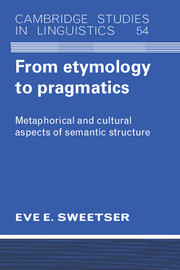Book contents
2 - Semantic structure and semantic change: English perception-verbs in an Indo-European context
Published online by Cambridge University Press: 05 June 2012
Summary
Introduction
As mentioned in chapter 1, recent work on polysemy structures (see Brugman 1988; G. Lakoff 1985) has suggested that a word meaning is a structured and unified entity. In order to better understand that structure, we need further investigation of the connections between the different (sub-)meanings of polysemous lexical items. In phonology, analysts have frequently assumed that units which were related, or could be classed together, would be more likely to undergo parallel historical changes. For the restricted semantic field of English perception-verbs, this chapter will investigate the interaction between synchronic semantic groupings and parallelisms in historical change of meaning. I shall argue that the historical and synchronic data point to one and the same cognitively based analysis of the relevant semantic domain.
The general study of semantic change has undergone a long period of relative neglect, largely because the phonological part of word history proved so much more immediately tractable to systematic analysis. Semantic shifts have been felt to be random, whimsical, and irregular; general rules concerning them are nearly impossible to establish. Of course, two hundred years ago the same charges might well have been leveled against phonological change, and only work based on the opposite assumption of regularity could have changed our understanding of sound change as it has been changed since then. But it is scarcely surprising that to many linguists, the non-phonological side of etymology appears inherently non-scientific. Synchronic as well as diachronic linguistics has found sound a more accessible domain for study than meaning.
- Type
- Chapter
- Information
- From Etymology to PragmaticsMetaphorical and Cultural Aspects of Semantic Structure, pp. 23 - 48Publisher: Cambridge University PressPrint publication year: 1990
- 1
- Cited by



